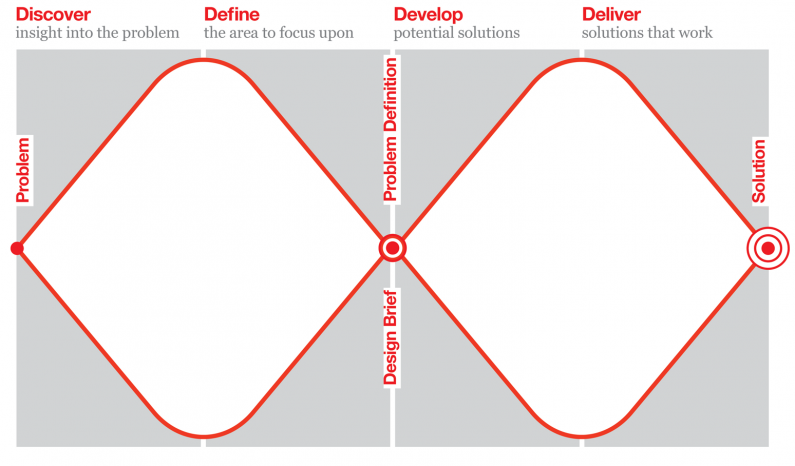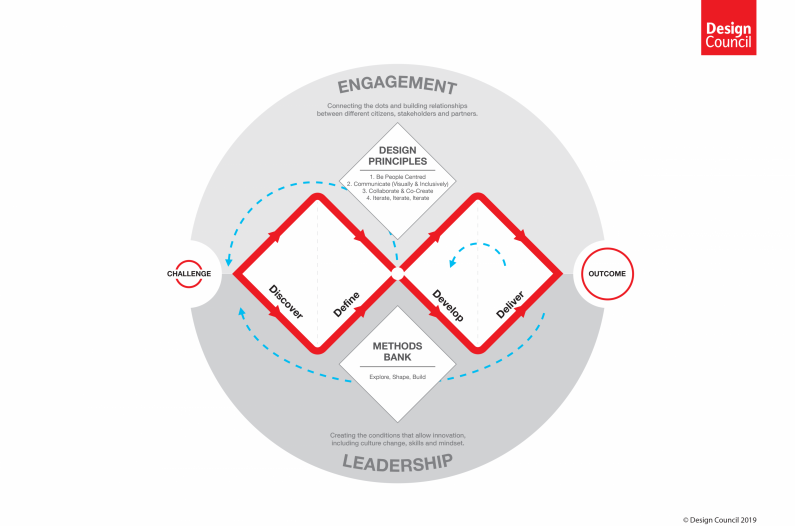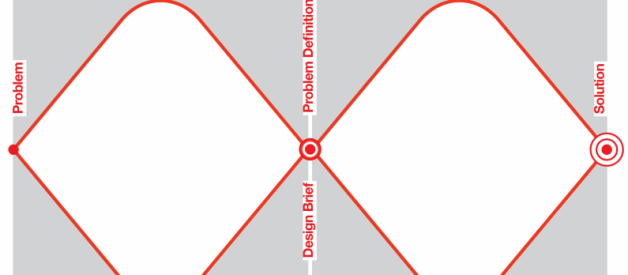The Double Diamond is no longer enough. For the past 15 years, the Double Diamond model of the design process has been the most used model to structure design projects. Or explain how the design process works to people. Or misuse to pretend design is a structured process. You can find a variation of the model on any second design slide deck or agency website. It?s origins go even further back to the divergence-convergence model proposed in 1996 by Bela Banathy. The design world has been undergoing some major shifts these past years. As more an more people are interested in how designers work and think, the inventors of the Double Diamond model thought it was about time for an update.
The original Double Diamond design process model was based on research on how designers work. Before the Double Diamond, the design process seemed like an unstructured chaotic mess. The Design Council found some structure while analyzing the way designers worked. They identified four phases in a design process:
- Discover: a deep dive into the problem we are trying to solve.
- Define: synthesizing the information from the discovery phase into a problem definition.
- Develop: think up solutions to the problem.
- Deliver: pick the best solution and build that.
They added the divergence-convergence idea of Bela Banathy to it and the Double Diamond was born.
 The original Double Diamond model
The original Double Diamond model
There are many things you can say about this model. I wrote about it before and before that. Many people did. It?s not perfect. No model is. A model is not reality, that is the definition of a model. It?s a representation of reality to explain something. It explained that there is some structure to be found in design processes. It showed that it?s necessary to do some research in the first diamond to get to better solutions in the second. It made it clear that when designers design, they do lots of things not just making stuff. I think it helped to make many a design process more rigorous.
It?s a classic. But maybe it is time for an update. That is what the Design Council thought at least. Recently, they published a new model. They don?t call it Double Diamond but Framework For Innovation:
 The new Double Diamond model: Framework For Innovation
The new Double Diamond model: Framework For Innovation
They basically extended the original Double Diamond model. The additions tell an interesting story about the changes design is going through:
- Design is used more and more for innovation. They call the model Framework For Innovation. That alone tells us that design is a great help when it comes to innovating. That is exactly what we see in the market: businesses that need to innovate turn to design for help, for a model.
- A design process alone will not save you. They added four other aspects to the model to turn in into an innovation framework. For innovation, you need a process, but you also need design principles, design methods, engagement, and leadership.
- Design is not a linear process. One of the biggest criticisms you can have on the original model is that is was basically a linear model. You went from A to B through two diamonds and that?s it. The whole Agile movement and Lean Startup?s thinking made it clear that design is not a linear process. It?s iterative. Designers iterate their way forward. In the new model, they added some blue circles to show people the iterative nature of design.
I think this is a nice move from the Design Council. As more and more people start to look to design for help with creativity and innovation, it?s important to show the world a more mature model of what design is. The original model was easy to understand but the maturity level in understanding design was not that high. Which was kinda okay for the past 15 years because the design maturity of people was not at a level that could process a more complex message. The simplicity of the Double Diamond and IDEO?s 5 step model of design helped the spread of design in the world. But the risk of this simplicity is that people get the wrong idea of design and they will get disappointed. If people really believe that just following four simple steps is all there is to design, they will drive right into the Trough of Disillusionment. They will be hugely disappointed in design and that is not good for design. I think the time is right for a little more complexity in the conversation about design. And this model could help with that.
In the new model, under ?design principles?, they added the main other mental models that are a good help in innovation projects:
- User Centered Design: ?be people centered?
- Visual Thinking: ?communicate visually?
- Co-creation: ?collaborate and co-create?
- Agile / Lean Startup: ?iterate, iterate, iterate?
Design works wonderfull in this constellation of UCD, Agile, Lean Startup and Visual Thinking. I crafted a neat model of this constellation in this blog.
This already adds a nice layer of complexity.
I also like the fact that they stress engagement and leadership as critical success factors. In all this talk about co-creation, the misconception might arise that we don?t need leadership anymore, that we can put all the responsibility on the process. And it?s also good to state the fact that without engagement, nothing flies. If design is involved in innovation, that means bigger changes, which means engagement is quintessential. Design can help a lot with engagement. It can make people enthusiastic by visualising ideas. It can create a platform for communication by making things concrete.
I?m enthusiastic about this new version of the classic design process model.
You can read what the Design Council says about it here.

Thank you for taking the time to read this article. I hope you enjoyed it. If you did, don?t forget to hit the clap button. I will dive deeper into the topics of Design Leadership in upcoming articles. If you follow me here on Medium, you will see them pop up on your Medium homepage. You can also connect with me on LinkedIn to see new articles in your timeline or talk to my bot at dennishambeukers.com 🙂


